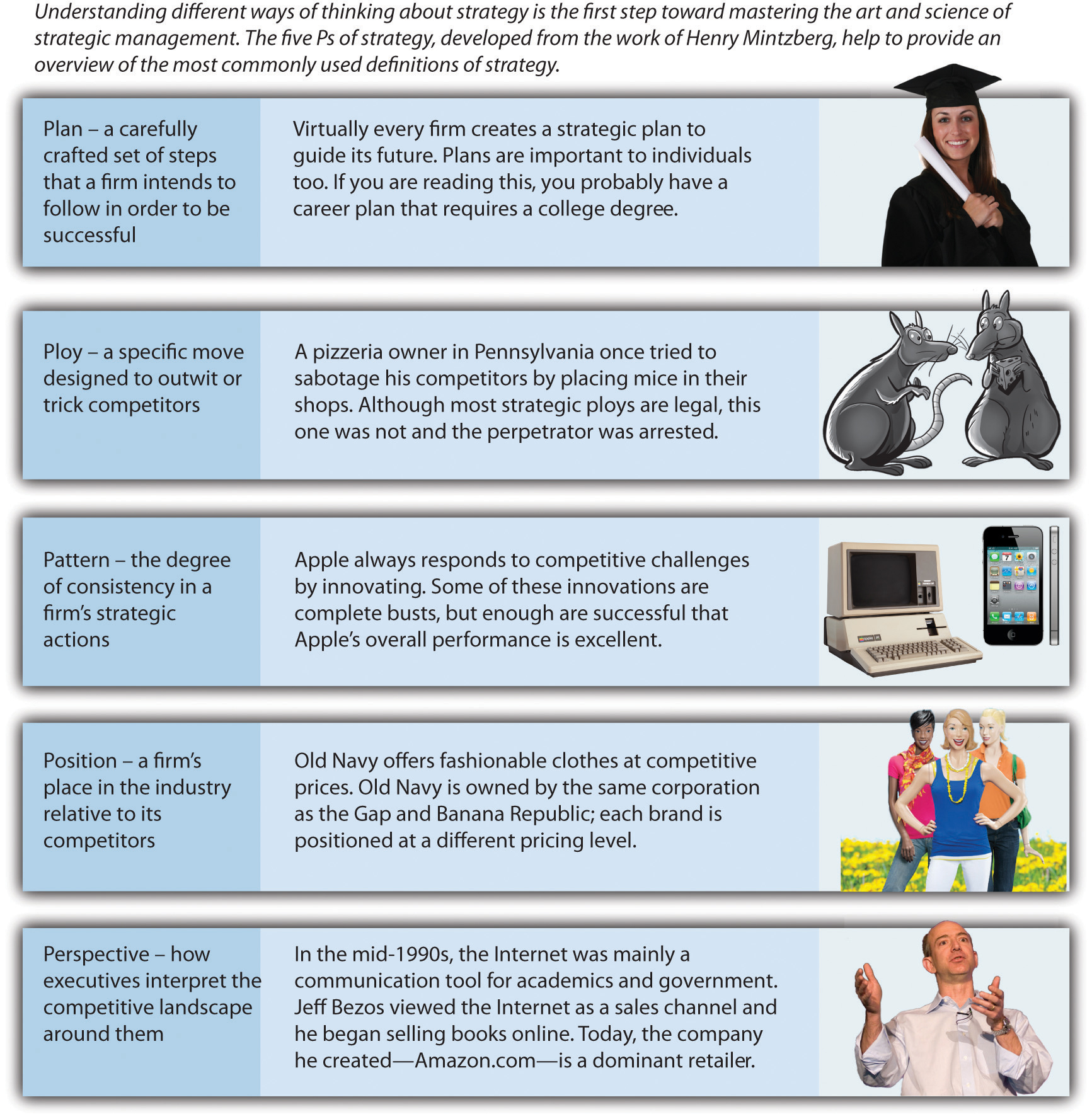Issues such as those currently faced by Apple are the focus of strategic management because they help answer the key question examined by strategic managementExamines how actions and events involving top executives (such as Steve Jobs), firms (Apple), and industries (the tablet market) influence a firm’s success or failure.—“Why do some firms outperform other firms?” More specifically, strategic management examines how actions and events involving top executives (such as Steve Jobs), firms (Apple), and industries (the tablet market) influence a firm’s success or failure. Formal tools exist for understanding these relationships, and many of these tools are explained and applied in this book. But formal tools are not enough; creativity is just as important to strategic management. Mastering strategy is therefore part art and part science.
This introductory chapter is intended to enable you to understand what strategic management is and why it is important. Because strategy is a complex concept, we begin by explaining five different ways to think about what strategy involves (Figure 1.1 "Defining Strategy: The Five Ps"). Next, we journey across many centuries to examine the evolution of strategy from ancient times until today. We end this chapter by presenting a conceptual model that maps out one way that executives can work toward mastering strategy. The model also provides an overall portrait of this book’s contents by organizing the remaining nine chapters into a coherent whole.
Defining strategy is not simple. Strategy is a complex concept that involves many different processes and activities within an organization. To capture this complexity, Professor Henry Mintzberg of McGill University in Montreal, Canada, articulated what he labeled as “the 5 Ps of strategy.” According to Mintzberg, understanding how strategy can be viewed as a plan, as a ploy, as a position, as a pattern, and as a perspective is important. Each of these five ways of thinking about strategy is necessary for understanding what strategy is, but none of them alone is sufficient to master the concept.Mintzberg, H. 1987. The strategy concept I: Five Ps for strategy. California Management Review, 30(1), 11–24.
Figure 1.1 Defining Strategy: The Five Ps

Images courtesy of Thinkstock (first); [citation redacted per publisher request] (second); Wikipedia (third); Old Navy (fourth); James Duncan Davidson from Portland, USA (fifth).
Strategic plansA carefully crafted set of steps that a firm intends to follow to be successful. are the essence of strategy, according to one classic view of strategy. A strategic plan is a carefully crafted set of steps that a firm intends to follow to be successful. Virtually every organization creates a strategic plan to guide its future. In 1996, Apple’s performance was not strong, and Gilbert F. Amelio was appointed as chief executive officer in the hope of reversing the company’s fortunes. In a speech focused on strategy, Amelio described a plan that centered on leveraging the Internet (which at the time was in its infancy) and developing multimedia products and services. Apple’s subsequent success selling over the Internet via iTunes and with the iPad can be traced back to the plan articulated in 1996.Markoff, J. 1996, May 14. Apple unveils strategic plan of small steps. New York Times. Retrieved from http://www.nytimes.com/1996/05/14/business/apple-unveils-strategic -plan-of-small-steps.html
A business modelDescribes the process through which a firm hopes to earn profits. should be a central element of a firm’s strategic plan. Simply stated, a business model describes the process through which a firm hopes to earn profits. It probably won’t surprise you to learn that developing a viable business model requires that a firm sell goods or services for more than it costs the firm to create and distribute those goods. A more subtle but equally important aspect of a business model is providing customers with a good or service more cheaply than they can create it themselves.
Consider, for example, large chains of pizza restaurants such as Papa John’s and Domino’s.

Franchises such as Pizza Hut provide an example of a popular business model that has been successful worldwide.
Image courtesy of Derek Jensen, http://wikimediafoundation.org/wiki/File:Bremen-indiana-pizza-hut.jpg.
Because these firms buy their ingredients in massive quantities, they pay far less for these items than any family could (an advantage called economies of scaleA cost advantage created when a firm can produce a good or service at a lower per unit price due to producing the good or service in large quantities.). Meanwhile, Papa John’s and Domino’s have developed specialized kitchen equipment that allows them to produce better-tasting pizza than can be created using the basic ovens that most families rely on for cooking. Pizza restaurants thus can make better-tasting pizzas for far less cost than a family can make itself. This business model provides healthy margins and has enabled Papa John’s and Domino’s to become massive firms.
Strategic plans are important to individuals too. Indeed, a well-known proverb states that “he who fails to plan, plans to fail.” In other words, being successful requires a person to lay out a path for the future and then follow that path. If you are reading this, earning a college degree is probably a key step in your strategic plan for your career. Don’t be concerned if your plan is not fully developed, however. Life is full of unexpected twists and turns, so maintaining flexibility is wise for individuals planning their career strategies as well as for firms.
For firms, these unexpected twists and turns place limits on the value of strategic planning. Former heavyweight boxing champion Mike Tyson captured the limitations of strategic plans when he noted, “Everyone has a plan until I punch them in the face.” From that point forward, strategy is less about a plan and more about adjusting to a shifting situation. For firms, changes in the behavior of competitors, customers, suppliers, regulators, and other external groups can all be sources of a metaphorical punch in the face. As events unfold around a firm, its strategic plan may reflect a competitive reality that no longer exists. Because the landscape of business changes rapidly, other ways of thinking about strategy are needed.
A second way to view strategy is in terms of ploys. A strategic ployA specific move designed to outwit or trick competitors. is a specific move designed to outwit or trick competitors. Ploys often involve using creativity to enhance success. One such case involves the mighty Mississippi River, which is a main channel for shipping cargo to the central portion of the United States. Ships traveling the river enter it near New Orleans, Louisiana. The next major port upriver is Louisiana’s capital, Baton Rouge. A variety of other important ports exist in states farther upriver.
Many decades ago, the governor of Louisiana was a clever and controversial man named Huey Long. Legend has it that Long ordered that a bridge being constructed over the Mississippi River in Baton Rouge be built intentionally low to the ground. This ploy created a captive market for cargo because very large barges simply could not fit under the bridge. Large barges using the Mississippi River thus needed to unload their cargo in either New Orleans or Baton Rouge. Either way, Louisiana would benefit. Of course, owners of ports located farther up the river were not happy.
Ploys can be especially beneficial in the face of much stronger opponents. Military history offers quite a few illustrative examples. Before the American Revolution, land battles were usually fought by two opposing armies, each of which wore brightly colored clothing, marching toward each other across open fields. George Washington and his officers knew that the United States could not possibly defeat better-trained and better-equipped British forces in a traditional battle. To overcome its weaknesses, the American military relied on ambushes, hit-and-run attacks, and other guerilla moves. It even broke an unwritten rule of war by targeting British officers during skirmishes. This was an effort to reduce the opponent’s effectiveness by removing its leadership.
Centuries earlier, the Carthaginian general Hannibal concocted perhaps the most famous ploy ever.

Hannibal’s clever use of elephants to cross the Alps provides an example of a strategic ploy.
Image courtesy of Wikipedia, http://en.wikipedia.org/wiki/File:Hannibal3.jpg.
Carthage was at war with Rome, a scary circumstance for most Carthaginians given their far weaker fighting force. The Alps had never been crossed by an army. In fact, the Alps were considered such a treacherous mountain range that the Romans did not bother monitoring the part of their territory that bordered the Alps. No horse was up to the challenge, but Hannibal cleverly put his soldiers on elephants, and his army was able to make the mountain crossing. The Romans were caught completely unprepared and most of them were frightened by the sight of charging elephants. By using the element of surprise, Hannibal was able to lead his army to victory over a much more powerful enemy.
Ploys continue to be important today. In 2011, a pizzeria owner in Pennsylvania was accused of making a rather unique attempt to outmaneuver two rival pizza shops. According to police, the man tried to sabotage his competitors by placing mice in their pizzerias. If the ploy had not been discovered, the two shops could have suffered bad publicity or even been shut down by authorities because of health concerns. Although most strategic ploys are legal, this one was not, and the perpetrator was arrested.Reuters. 2011, March 1. Philadelphia area pizza owner used mice vs. competition—police. Retrieved from news.yahoo.com/s/nm/20110301/od_uk_nm/oukoe_uk_crime_pizza
Strategy as patternThe extent to which a firm’s actions over time are consistent. is a third way to view strategy. This view focuses on the extent to which a firm’s actions over time are consistent. A lack of a strategic pattern helps explain why Kmart deteriorated into bankruptcy in 2002. The company was started in the late nineteenth century as a discount department store. By the middle of the twentieth century, consistently working to be good at discount retailing had led Kmart to become a large and prominent chain.
By the 1980s, however, Kmart began straying from its established strategic pattern. Executives shifted the firm’s focus away from discount retailing and toward diversification. Kmart acquired large stakes in chains involved in sporting goods (Sports Authority), building supplies (Builders Square), office supplies (OfficeMax), and books (Borders). In the 1990s, a new team of executives shifted Kmart’s strategy again. Brands other than Kmart were sold off, and Kmart’s strategy was adjusted to emphasize information technology and supply chain management. The next team of executives decided that Kmart’s strategy would be to compete directly with its much-larger rival, Walmart. The resulting price war left Kmart crippled. Indeed, this last shift in strategy was the fatal mistake that drove Kmart into bankruptcy. Today, Kmart is part of Sears Holding Company, and its prospects remain uncertain.
In contrast, Apple is very consistent in its strategic pattern: It always responds to competitive challenges by innovating. Some of these innovations are complete busts. Perhaps the best known was the Newton, a tablet-like device that may have been ahead of its time. Another was the Pippin, a video game system introduced in 1996 to near-universal derision. Apple TV, a 2007 offering intended to link televisions with the Internet, also failed to attract customers. Such failures do not discourage Apple, however, and enough of its innovations are successful that Apple’s overall performance is excellent. However, there are risks to following a pattern too closely. A consistent pattern can make a company predictable, a possibility that Apple must guard against in the years ahead.
Viewing strategy as a plan, a ploy, and a pattern involve only the actions of a single firm. In contrast, the next P—strategy as positionA firm’s place in the industry relative to its competitors.—considers a firm and its competitors. Specifically, strategy as position refers to a firm’s place in the industry relative to its competitors. McDonald’s, for example, has long been and remains the clear leader among fast-food chains. This position offers both good and bad aspects for McDonald’s. One advantage of leading an industry is that many customers are familiar with and loyal to leaders. Being the market leader, however, also makes McDonald’s a target for rivals such as Burger King and Wendy’s. These firms create their strategies with McDonald’s as a primary concern. Old Navy offers another example of strategy as position. Old Navy has been positioned to sell fashionable clothes at competitive prices.

Old Navy occupies a unique position as the low-cost strategy within the Gap Inc.’s fleet of brands.
Image courtesy of Lindsey Turner, http://www.flickr.com/photos/theogeo/2148416495.
Old Navy is owned by the same corporation (Gap Inc.) as the midlevel brand the Gap and upscale brand Banana Republic. Each of these three brands is positioned at a different pricing level. The firm hopes that as Old Navy’s customers grow older and more affluent, they will shop at the Gap and then eventually at Banana Republic. A similar positioning of different brands is pursued by General Motors through its Chevrolet (entry level), Buick (midlevel), and Cadillac (upscale) divisions.
Firms can carve out a position by performing certain activities in a different manner than their rivals. For example, Southwest Airlines is able to position itself as a lower-cost and more efficient provider by not offering meals that are common among other airlines. In addition, Southwest does not assign specific seats. This allows for faster loading of passengers. Positioning a firm in this manner can only be accomplished when managers make trade-offs that cut off certain possibilities (such as offering meals and assigned seats) to place their firms in a unique strategic space. When firms position themselves through unique goods and services customers value, business often thrives. But when firms try to please everyone, they often find themselves without the competitive positioning needed for long-term success. Thus deciding what a firm is not going to do is just as important to strategy as deciding what it is going to do.Porter, M. E. 1996, November–December. What is strategy? Harvard Business Review, 61–79.
To gain competitive advantage and greater success, firms sometimes change positions. But this can be a risky move. Winn-Dixie became a successful grocer by targeting moderate-income customers. When the firm abandoned this established position to compete for wealthier customers and higher margins, the results were disastrous. The firm was forced into bankruptcy and closed many stores. Winn-Dixie eventually exited bankruptcy, but like Kmart, its future prospects are unclear. In contrast to firms such as Winn-Dixie that change positions, Apple has long maintained a position as a leading innovator in various industries. This positioning has served Apple well.
The fifth and final P shifts the focus to inside the minds of the executives running a firm. Strategy as perspectiveHow executives interpret the competitive landscape around them. refers to how executives interpret the competitive landscape around them. Because each person is unique, two different executives could look at the same event—such as a new competitor emerging—and attach different meanings to it. One might just see a new threat to his or her firm’s sales; the other might view the newcomer as a potential ally.
An old cliché urges listeners to “make lemons into lemonade.” A good example of applying this idea through strategy as perspective is provided by local government leaders in Sioux City, Iowa. Rather than petition the federal government to change their airport’s unusual call sign—SUX—local leaders decided to leverage the call sign to attract the attention of businesses and tourists to build their city’s economic base. An array of clothing and other goods sporting the SUX name is available at http://www.flysux.com. Some strategists such as these local leaders are willing to take a seemingly sour situation and see the potential sweetness, while other executives remain fixated on the sourness.
Executives who adopt unique and positive perspectives can lead firms to find and exploit opportunities that others simply miss. In the mid-1990s, the Internet was mainly a communication tool for academics and government agencies. Jeff Bezos looked beyond these functions and viewed the Internet as a potential sales channel. After examining a number of different markets that he might enter using the Internet, Bezos saw strong profit potential in the bookselling business, and he began selling books online. Today, the company he created—Amazon—has expanded far beyond its original focus on books to become a dominant retailer in countless different markets. The late Steve Jobs at Apple appeared to take a similar perspective; he saw opportunities where others could not, and his firm has reaped significant benefits as a result.